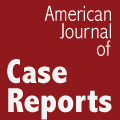Get your full text copy in PDF
Andrzej Lewiński, Barbara Pniewska-Siark, Anna Jeziorowska, Dorota Pastuszak-Lewandoska, Ewa Brzeziańska
Med Sci Tech 2005; 46(3): RA9-14
ID: 881470
Objective: In this report, we investigated 9 affectedPSpatientsand21non-affectedindividualsfrom7 unrelatedfamilies by SSCP screening and direct sequencing of 6 exons of the SLC26A4 gene, conducted within the introductory
molecular PS analysis program in Poland (6PO5B05621). Theclinicalandexperimentalstudieswereapprovedby the ethics committee. Methods: Pendred syndrome (PS), an autosomal-recessive condition, characterized by sensorineural hearing loss (SNHL), goitre, and – in the prevalent part of patients – hypothyroidism, is caused by mutations in the PDS (SLC26A4) gene, located on chromosome 7q22-q31. It encodes a chloride-iodide transporter (pendrin) expressed in the thyroid, inner ear and kidney. In this study, conducted within the introductory molecular
PS analysis program in Poland, we performed clinical analysis and mutation analysis in 7 families with PS. We investigated 9 affectedPSpatientsand21non-affectedindividualsbySSCPscreeninganddirectsequencingof6 exons of the SLC26A4 gene. Conclusions: In case of PS patients, two frequent missense point mutations have been identifiedintwodifferentfamilies.Thefirstmutationisleucinetoprolinesubstitution(L236P),whichresultsfromT to C transition at nucleotide 707 of the SLC26A4 gene. Leucine is a part of 3rd extracellular loop between transmembrane
domains 5 and 6. Thesecondmutation-T416P-changesthreonineresidueintoproline.Threonineat position 416 is located in the 5th extracellular loop between transmembrane domains 9 and 10. Thesubstitutionresults from a 1246 A to C transversion. ThepresentedSLC26A4 mutations, found in patients with Pendred syndrome,
are the firstreportedinPoland.TheaimofthisstudywastocomparetheclinicalfeaturesofthePSphenotypeobserved in 3 patients from two differentfamilieswithdetectedmutationsofSLC26A4 gene. (Clin. Exp. Med. Lett. 2005; 46(3):9-14)
Keywords: Pendred syndrome, SLC26A4 gene, pendrin, missense mutations



